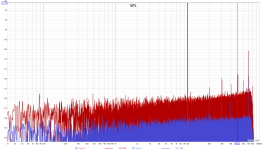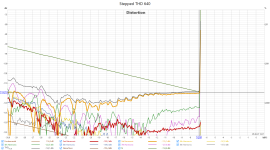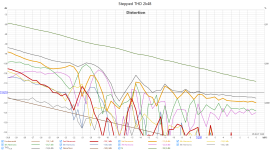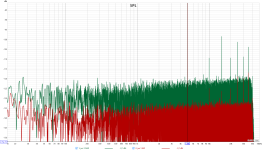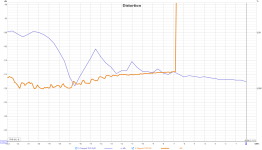Could have been a nice standard feature in Audacity or REW. Simple but effective to keep noise down but allow for overload. (When overload is like in the example, just a fraction of the time of the recording)
For stepped measurements it is the noise that is interesting at low levels and distortion at high levels. This could solve some of this problem for one take measurements.
For DUTs with limited current drive capability, but low noise, especially.
(The cutover level don't have to be at 0dBFS for high gain channel, could be at -6 or - 20dB)
For stepped measurements it is the noise that is interesting at low levels and distortion at high levels. This could solve some of this problem for one take measurements.
For DUTs with limited current drive capability, but low noise, especially.
(The cutover level don't have to be at 0dBFS for high gain channel, could be at -6 or - 20dB)
Last edited:
I tested that with 20KHz max amplitude for 1 ms every 1-second of the periodical burst to see if I could notice switching artifacts - nothing even after amplifying for 50db.
BTW, it seems Matlab audiowrite function adds 16bit dither, perhaps that noise masks some clicks.
BTW, it seems Matlab audiowrite function adds 16bit dither, perhaps that noise masks some clicks.
Maybe you can try posting on the Audacity forum with that request? Actually, all is so simple, no idea what they're afraid of.Could have been a nice standard feature in Audacity
Just curious - what problem does this solve?
I get why commercial audio interface and recorder manufacturers like this. It provides a feature that is appealing to users who don't want to set levels so accurately. But, for measurements?
I'm not proud, so I'm fine with being told what I'm probably missing.
I get why commercial audio interface and recorder manufacturers like this. It provides a feature that is appealing to users who don't want to set levels so accurately. But, for measurements?
I'm not proud, so I'm fine with being told what I'm probably missing.
If you ever wanted to record explosive sounds (gun shot, lightning thunder, etc) and you have only one try, you know why doing away with any headroom issues is a good thing.Just curious - what problem does this solve?
I get why commercial audio interface and recorder manufacturers like this. It provides a feature that is appealing to users who don't want to set levels so accurately. But, for measurements?
I'm not proud, so I'm fine with being told what I'm probably missing.
And for measurements, stacked ADC's and DACs's can completely put away with annoying level (auto-)ranging issues.
It will not take too long until this will be standard practice and nobody will question its benefits.
It is like with electrical vehicles, nobody really misses manual (or automatic) gear shifting to the optimal torque range like we had to do with combustion engines.
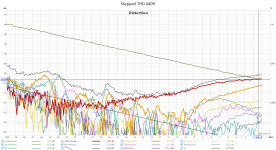
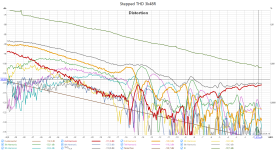
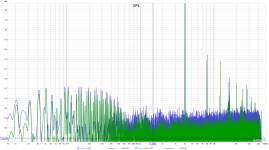
This real world nonperfect 4 series "cheap" opamp measurements illustrates some of the measurement dilemma
640R gives low noise but can be overloaded and loads the cirquit so odd harmonics rise.
3k48 has higher measurement noise, but the loading is less. So more real harmonics for normal loading.
At low level I want to se the noise. At high level i dont want signal overload and I dont want excessive loading of circuit.
I have added 100Hz in one of the FFT plots for clarity.
4000Hz test tone at max about -3dBFS (640) and -13dBFS (3k48)
(Single ended with poorly regulated switchmode supply)
Last edited:
Hm, thought the harmonics would be lower with higher input impedance at low outut volume, but no.
Single ended. 640 ohm red, 3K48 green
ESS..39 dac, just 1 single ended part of differential out into ADCiso
So then the input impedance for the ADCiso input amps is to high for lowest THD? Ref https://audioxpress.com/article/modern-op-amp-distortion-tests-part-1-bjt-input-devices

Single ended. 640 ohm red, 3K48 green
ESS..39 dac, just 1 single ended part of differential out into ADCiso
So then the input impedance for the ADCiso input amps is to high for lowest THD? Ref https://audioxpress.com/article/modern-op-amp-distortion-tests-part-1-bjt-input-devices
Last edited:
My idea, was that at 2k48 the noise is higher but harmonics are lower
Higher termal noise and less losding of DUT.
But i did not understand that the input resistance of the ADC amp generates more harmonics than the DUT.
So the ADC amp need low resistor setting to work well.
Higher termal noise and less losding of DUT.
But i did not understand that the input resistance of the ADC amp generates more harmonics than the DUT.
So the ADC amp need low resistor setting to work well.
So switching from 640 to 2k48 raises both noise and distortion relativ to signal. So switching may not look that good. As it is no longer the distortion of the DUT
The plots and the garbage are more than strange. What is your REW settings - preferences, distortion settings, appearance - screenshots would help.
It is actually very useful for audio and not just for fun.All this just for fun, I'm not a believer if cascaded ADC anybody needs for audio, excluding marketing guys. Industrial instrumentation, maybe.
There are products in the market, which use this technique. I have also made designs for wireless audio (microphones and belt packs), where a dynamic range above 120dB was required (analog in to analog out). On the transmit side this was implemented with cascaded ADC's and proper DSP processing.
The main advantages were that it could be implemented with a low power (battery operated) and low cost ADC. And since most ADC's for audio have at least two channels, the additional circuits were very low cost also.
- Home
- Vendor's Bazaar
- Cosmos APU a notch+LNA $70 to outperform APx555b for $30,000
